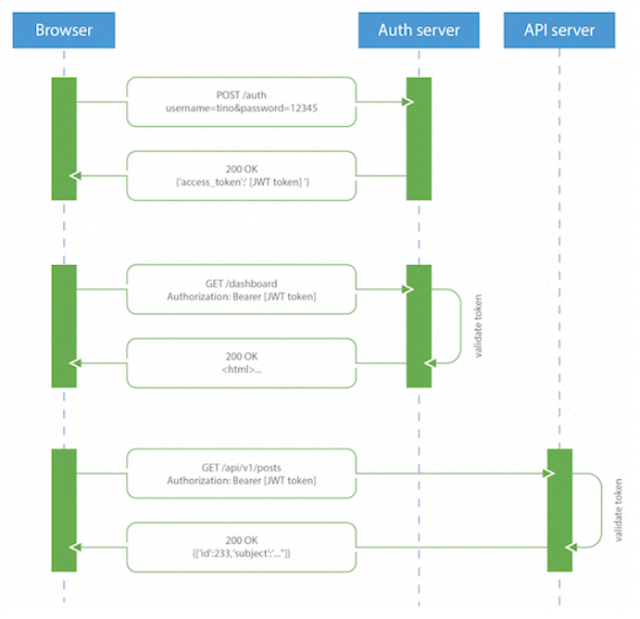JSON Web Token: Security for Applications
Rafael Salerno dissects the components of the JSON Web Token and walks through an example of how to authenticate a user to access an API server.
Join the DZone community and get the full member experience.
Join For FreeJSON Web Token, or JWT, is an open standard RFC 7519 that defines a compact and self-contained way for securely transmitting information between parties as a JSON object.
Each piece of information can be verified and trusted because it is digitally signed.
JWTs can be signed using a secret (with the HMAC algorithm) or a public/private key pair using RSA.
Some important concepts:
- Compact: JWTs can be sent through a URL, POST parameter, or inside an HTTP header.
- Self-contained: The payload contains all the required information about the user, avoiding the need to query the database more than once.
When you should use JSON Web Tokens:
- Authentication: This is the most common scenario for using JWT. Once the user is logged in, each subsequent request will include the JWT, allowing the user to access routes, services, and resources that are permitted with that token.
- Information Exchange: JSON Web Tokens are a good way of securely transmitting information between parties, because as they can be signed, for example using public/private key pairs, you can be sure that the senders are who they say they are.
JWT Structure
A complete JWT is represented something like this:
eyJhbGciOiJIUzI1NiIsInR5cCI6IkpXVCJ9.eyJleHAiOjEzODY4OTkxMzEsImlzcyI6ImppcmE6MTU0ODk1OTUiLCJxc2giOiI4MDYzZmY0Y2ExZTQxZGY3YmM5MGM4YWI2ZDBmNjIwN2Q0OTFjZjZkYWQ3YzY2ZWE3OTdiNDYxNGI3MTkyMmU5IiwiaWF0IjoxMzg2ODk4OTUxfQ.uKqU9dTB6gKwG6jQCuXYAiMNdfNRw98Hw_IWuA5MaMoThis token could be sliced in 3 parts:
Header
eyJhbGciOiJIUzI1NiIsInR5cCI6IkpXVCJ9.Payload
eyJleHAiOjEzODY4OTkxMzEsImlzcyI6ImppcmE6MTU0ODk1OTUiLCJxc2giOiI4MDYzZmY0Y2ExZTQxZGY3YmM5MGM4YWI2ZDBmNjIwN2Q0OTFjZjZkYWQ3YzY2ZWE3OTdiNDYxNGI3MTkyMmU5IiwiaWF0IjoxMzg2ODk4OTUxfQ.Signature
uKqU9dTB6gKwG6jQCuXYAiMNdfNRw98Hw_IWuA5MaMoEach part is separated by “.”
<base64url-encoded header>.<base64url-encoded claims>.<base64url-encoded signature>Here one simple sample of the flow to authentication of User to access a API Server.
I did two samples with JWT, first with main method call some others method to create token and another with Spring Boot call some rest operations.
First Example
dependency:
compile'io.jsonwebtoken:jjwt:0.7.0'package com.example;
import java.security.Key;
import javax.crypto.SecretKey;
import io.jsonwebtoken.CompressionCodecs;
import io.jsonwebtoken.Jwts;
import io.jsonwebtoken.SignatureAlgorithm;
import io.jsonwebtoken.impl.crypto.MacProvider;
public class PocAutorizationApplication {
private final String key = "teste";
public static void main(String[] args) {
PocAutorizationApplication poc = new PocAutorizationApplication();
poc.desCompactJws(poc.compactJws(new User("user", "password").toString()));
}
public String compactJws(String user) {
String compactJws = Jwts.builder()
.setSubject(user)
.signWith(SignatureAlgorithm.HS512, key)
.compact();
System.out.println("compactJws = "+compactJws);
return compactJws;
}
public String desCompactJws(String compactJws) {
String desCompactJws = Jwts.parser()
.setSigningKey(key)
.parseClaimsJws(compactJws)
.getBody()
.getSubject();
System.out.println("desCompactJws = "+ desCompactJws);
return desCompactJws;
}
} The second sample is a POC with JWT and Spring Boot, where I created some filters to check token on Header and I put some validations to Token. (I put just importants code parts)
dependencies {
compile('org.springframework.boot:spring-boot-starter-web')
compile group: 'org.apache.httpcomponents', name: 'httpclient', version: '4.5.2'
compile 'io.jsonwebtoken:jjwt:0.7.0'
testCompile('org.springframework.boot:spring-boot-starter-test')
}Operations
Login return Token and put Token in Header
User get use and pass by Header and decompact token
Validation is check if Token is valid
Users is to list users avaliable
@RestController
public class UserService {
@Autowired
private Authentication authentication;
@Autowired
private UserBuilder userBuilder;
@RequestMapping(value = "/login", method = RequestMethod.POST)
public String login(HttpServletResponse response,@RequestBody User user) throws IOException {
System.out.println(user);
String token = authentication.compactJws(new ObjectMapper().writeValueAsString(user));
response.setHeader("X-Auth-Token", token);
return token ;
}
@RequestMapping(value = "/user", method = RequestMethod.GET)
public String user(HttpServletRequest request) throws IOException {
System.out.println(request.getHeader("X-Auth-Token"));
return authentication.desCompactJws(request.getHeader("X-Auth-Token"));
}
@RequestMapping(value = "/validation/token", method = RequestMethod.POST)
public boolean validationToken(HttpServletRequest request) throws IOException {
return true;
}
@RequestMapping(value = "/users", method = RequestMethod.POST)
public List<User> listUsers(HttpServletRequest request,HttpServletResponse response) throws Exception {
return userBuilder.users;
}
}Class to compact and decompact.
@Component
public class Authentication {
private final String key = "teste";
private final int TEMPO_MAX_SESSAO=10;
public String compactJws(String user) {
String compactJws = Jwts.builder()
.setSubject(user)
.signWith(SignatureAlgorithm.HS512, key)
.compact();
System.out.println("compactJws = " + compactJws);
return compactJws;
}
public String desCompactJws(String compactJws) {
String desCompactJws = "";
try{
desCompactJws = Jwts.parser()
.setSigningKey(key)
.parseClaimsJws(compactJws)
.getBody()
.getSubject();
System.out.println("desCompactJws = " + desCompactJws);
}
catch (MalformedJwtException e) {
return "Invalid Token";
}
return desCompactJws;
}
}Filter class to check if operation is different from login, should check if contains token in header and user/password are valid.
@Component
public class AuthFilter implements Filter{
@Autowired
private Authentication authentication;
@Autowired
private UserBuilder userBuilder;
@Override
public void doFilter(ServletRequest req, ServletResponse res, FilterChain chain) throws IOException, ServletException {
HttpServletRequest request = (HttpServletRequest) req;
HttpServletResponse response = (HttpServletResponse) res;
if(request.getRequestURI().contains("login")) {
chain.doFilter(request, response);
return;
}
try {
if(getToken(request.getHeader("X-Auth-Token"))){
response.setHeader("X-Auth-Token", request.getHeader("X-Auth-Token"));
chain.doFilter(request, response);
return;
}
response.sendError(HttpStatus.UNAUTHORIZED.value());
}
catch (Exception e) {
e.printStackTrace();
response.sendError(HttpStatus.UNAUTHORIZED.value());
}
}
private boolean getToken(String token) throws Exception{
if(token != null && !token.isEmpty() && validationToken(token))
return true;
return false;
}
private boolean validationToken(String token) throws JsonParseException, JsonMappingException, IOException {
String user = authentication.desCompactJws(token);
if(user.equals("Invalid Token")) return false;
User out = new ObjectMapper().readValue(user, User.class);
Optional<User> userValid = userBuilder.users.stream().
filter(x-> x.getUser().equals(out.getUser())&& x.getPass().equals(out.getPass()))
.findFirst();
return userValid.isPresent();
}
@Override
public void init(FilterConfig filterConfig) throws ServletException {
}
@Override
public void destroy() {
}
}Here is the complete example with Spring Boot and JWT.
Opinions expressed by DZone contributors are their own.


Comments